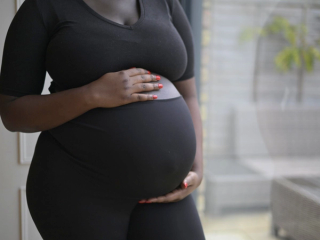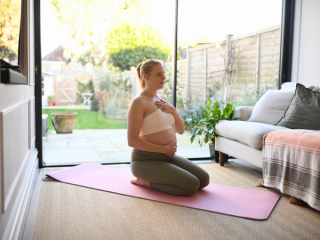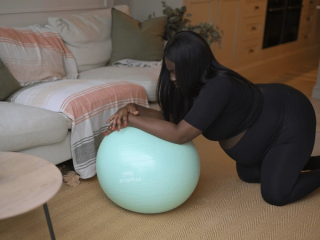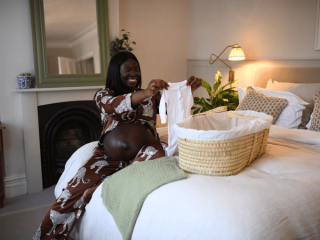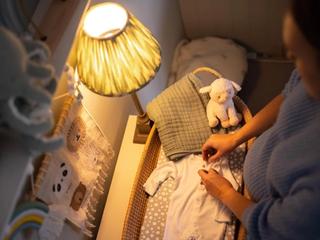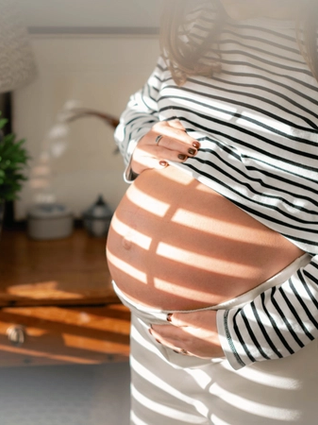
- Home
- Advice And Support
- Pregnancy
- Labour & Birth
- What Happens During Labour?
What really happens during labour?
Discover what really happens during labour in this informative guide. Learn about the three stages of labour, from contractions to birth, and beyond.
Labour is an incredible process of transformation, and your body will go through some changes in order to bring your baby into the world. Labour is split into 3 distinct stages:
- The first stage of labour which is everything that happens leading up to the birth
- The second stage of labour which is the birth of the baby
- The third stage which is when the placenta is delivered
Keep reading as we dive in a little more to explain the stages of labour in depth and what you can expect during this time.
The First Stage of Labour
Any mum will tell you that having a baby isn't called “labour” for nothing – it's a big job! However, it's a job your body was designed to do, and you'll have plenty of support to help you through. Plus, you've got the best reward ever waiting at the end of it – meeting your baby!
The first stage of labour is usually the longest stage, and is broken down into 3 phases; the latent phase of labour, active labour, and the transition into second stage, or transitional labour.
First phase: Latent labour
Latent labour is the very start and can look different for different women. For some this may last for a few hours, others may find it’s a stop start process for several days. During this process, the cervix is beginning to soften, ‘thin out’ or efface, and dilate.
The beginning of labour can feel a bit different for different women. You might experience:
- period-like pains
- backache
- a slightly upset stomach or feeling a bit sick
feeling a bit 'under the weather’ - a ‘show’ losing your mucous plug
All of this means your body is getting ready for the work ahead!
You may be wondering how long do contractions last? Well this depends on the progression of labour. The period type pains are contractions that come and go, perhaps coming every 15 minutes, 10 minutes or closer. They usually start without any particular pattern to them, but get more regular, stronger, and closer together over time.
Once these period type cramping pains are happening every five minutes and are lasting 40-60 seconds, it's time to ring the midwife or maternity ward for advice on when to come in. It's perfectly okay to walk around if you feel like it – in fact, this may help move the labour along. Be sure to drink plenty of water and eat small snacks to keep your energy up.
Sometimes during this stage you may notice that you've passed a bit of mucus, which might be pink or slightly tinted with blood. This is called a “show,” and it's totally normal – though if there is lots of blood, you should ring the hospital or midwife straightaway.
If you are assessed by the midwife and it’s confirmed you are in active labour, the latent phase has ended. At this point, your contractions will be strong and coming very close together. Your cervix will be dilating and is likely to be over 3-4cm dilated. Once the contractions 3 minutes apart how long ‘till birth? This depends on a number of factors including the position of the baby, your environment and your mindset. It could take anywhere from 2-24 hours!
Second phase: Active labour
Active labour is probably the most intense period. Contractions are strong and are coming close together. You may have been practising relaxation techniques such as hypnobirthing to help keep you focused. If you feel you need pain relief, this is a good time to discuss options with your midwife. The cervix continues to dilate throughout this time, and at some point, usually when you are around 7-9cm dilated, you’ll transition into the second stage.
Third phase: Transitional stage
The transitional stage can sometimes make you feel worried, as adrenaline kicks in. It’s not uncommon for women to say things like “I want to go home”, or “I’ve had enough”. This is a sign that baby is very nearly here!
Contractions will often feel like they are back-to-back during transition. When the transitional phase is over, the cervix is fully dilated and the head starts to descend down, leading to the second stage of labour.
The Second Stage of Labour
This is the big moment! The second stage of labour begins when your cervix (the entrance of the uterus) is fully open, and ends with the birth of your baby. Your midwife may offer to check via a vaginal examination and tell you that you're fully dilated. Examinations are not always necessary and remember, whether you have them or not is totally your decision.
If the baby is ready to be born, you'll probably feel an overwhelming need to push if you don’t have an epidural. If you have an epidural, you may need guidance on when to push as you may not feel the urge. In many cases if you’re having a physiological birth your midwife will not need to do an examination to check your cervix and will be able to monitor from external signs and can be guided by you.
If this is your first baby, this stage could take over an hour, but mums having their second or third babies often find it goes more quickly. You may want to consider your positioning here as laying on your back isn’t the best position to push your baby out. Side laying, on all fours or leaning over the bed if you have an epidural can be great positions.
Unless you’re using hypnobirthing. once your baby's head is visible, your midwife might ask you to slow the pushing down and breathe instead. This helps to slow things down and avoid a tear. When this happens, you'll know you're nearly there – your baby should appear with the next contraction or two!
When your little one is born, the midwife will place your baby onto your chest for the magical skin to skin contact and then clamp and cut the cord once its stopped pulsating and delivering oxygen, stem cell rich blood to your baby. Some babies might need a bit of oxygen or some help to clear out the nose and mouth, but the midwife will bring your baby to you as soon as possible for that all-important first cuddle.
The Third Stage of Labour
It may come as a surprise that there is a third stage of labour, especially once you’ve given birth to your baby. In fact, this stage, when you give birth to the placenta, usually it doesn't require much effort from you - but it's very important for your postnatal health.
You can choose to have an injection to help this stage go more quickly, or you can let things proceed naturally, which may take up to an hour or so. If you opt for the injection is given just after birth and helps the uterus to contract, gently pushing out the placenta. The injection can make you feel sick or vomit, some mums prefer to wait and see rather than have the medication. The actual delivery of the placenta does not hurt.
Finally, the midwife will check that your uterus is well contracted by placing her hand on your abdomen near your belly button. This is very important, because a poorly contracted uterus can cause excessive bleeding. She will then check the placenta and membranes to make sure they are all complete, because if any parts remain in the uterus, they could cause infection or bleeding.
You might experience some further pains (similar to contractions) for a while after birth. These are called 'after pains,' and they mean that your uterus is contracting back to its pre-pregnancy size. The more babies you have the more uncomfortable this may be. You may also feel these pains more strongly during breastfeeding; this is because breastfeeding makes your body release oxytocin, the same hormone that made your uterus contract during labour.
If you have any questions about labour please speak to your midwife, who will be happy to help you.
Breaking waters (amniotic fluid)
So you may think that we have forgotten to mention this is the stages, but that’s because it can happen at any stage, even before latent labour begins! Membranes are like a sac around the baby containing your “waters” - the amniotic fluid surrounding your baby in the womb. For most women, the waters break during the first stage of labour.
Around 10% however, will find that this happens before labour begins, or not at all. If the baby is born with the membranes intact, this is called an ‘en caul’ birth. In this scenario, the membranes are gently opened at birth allowing the baby to take their first breath. In some cases, the midwife may break it for you should you consent to that, and if it’s indicated. Some women experience a trickle, and others a gush.
If your waters break before your labour starts, (or if you think they may have), make a note of the time and contact your maternity unit. You can wear a sanitary pad (not a tampon) to keep things dry.
Frequently Asked Questions About Labour
Labour is not always text book and often stops and starts. Often, it’s because the baby is not in an optimal position to be able to put pressure on the cervix and help it to dilate. If this happens, depending on the phase you’re in, your midwife may suggest mobilising and changing positions, getting rest or hydrating yourself. In most cases, after a brief delay or slow down of labour, it begins again.
This depends on which phase you’re in. If you are in the latent phase, or early labour, you may find that some contractions last 15 seconds and others last 40 or more. To be able to effectively dilate your cervix, they need to last a fair amount of time. During the second stage, you may find that contractions slow down a little help allow you to conserve energy and take a breather between pushes.
This is common in the latent phase. Some women find that this can happen on and off for several nights. This can happen for several reasons including hormonal fluctuations, the body’s circadian rhythm prioritising relaxation and rest, and reduced activity. When you’re active during the day, gravity and movement help your baby settle into position, which can trigger contractions. When you lie down and relax, the lack of physical activity may cause contractions to subside temporarily
While it can be frustrating, this pattern of stopping contractions during rest is generally normal in early labour. As labour progresses and becomes more established, contractions will continue regardless of whether you are resting or asleep.
Most women who experience a physiological birth (one without intervention) will not have any issues with the second stage of labour. Sometime however, issues can present if the baby’s head is in an unusual position. Some positions can make it tricky for the head to pass through. The second stage of labour, which begins when the cervix is fully dilated and ends with the delivery of the baby, can be a physically and emotionally intense time. Although it is often the most rewarding stage, it can also present certain challenges or problems.
One common issue is prolonged labour. This occurs when the pushing phase takes much longer than expected. It can be due to several factors, such as the baby’s position, with posterior or breech positions making it harder for the baby to descend through the birth canal. Exhaustion can also play a role; by this stage, many women are tired, which can make effective pushing difficult.
Tears in the vaginal or perineal tissues are also common during this stage. While some tearing is mild and heals well, more severe tears, particularly those extending into the rectal muscles, can lead to complications like pain, incontinence, or infection, which may require surgical repair. Perineal massage and slow pushing can help to reduce perineal trauma.
